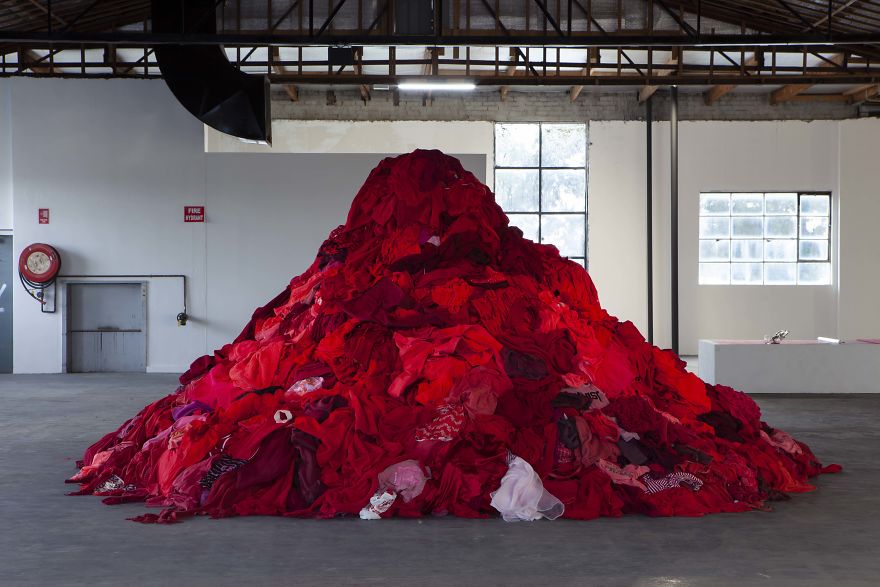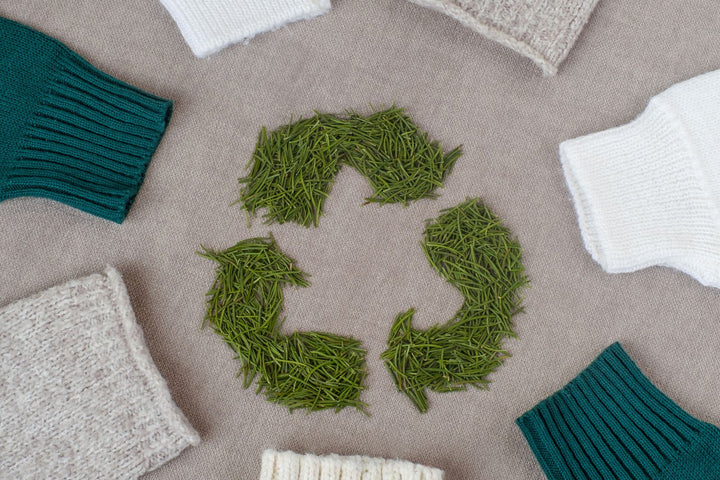A t-shirt shouldn't cost the earth. The fast fashion industry is a murky, horrid world jam-packed full of exploitation, dirty dealing and corner-cutting. It's one of the reasons we don't like to call ourselves a fashion company - aside from the fact that none of the Kardashians choose to wear our stuff. It's not a great conversation starter to admit that you're part of an industry responsible for 4-10% of global greenhouse emissions; that sends around 13 million tonnes of material to landfills annually in the UK alone and is a principal driver of climate change.

Many companies are determined to clean up their act - given the unavoidable truth that we're living on a planet dying from the greed of an elite few.
One word regularly deployed in marketing content is 'sustainability'. It's used as follows: "We're the most sustainable we've ever been!" or "Buy our product and live a sustainable lifestyle". You might even see the term' ethical fashion'.
But what does sustainability actually mean? Its overuse in advertising and corporate press releases has stripped any real, material meaning. However, for the purposes of this article, which is to examine sustainability throughout the fashion sector and strip away the bullshit, we should get some basic definitions together.
Sustainability - what actually is it?
When something is described as 'sustainable', it refers to some kind of process or a state of being that can continue functioning over a period of time. In the context of human industry and development, we can take it to mean the 'avoidance of the depletion of natural resources to maintain an ecological balance.'
But that's only part of the story. Sustainability also refers to the economic and social factors surrounding a business or industry.
Simply put, it means that we're not using more resources - including human - than we can regenerate or that the environment can replace. At this point, it's essential to understand that every single economic market on the planet has its very base source in the natural environment. Economic sustainability refers to the cost to the pocket of whoever has a financial interest in that particular industry. Social sustainability refers to the impact on humans.
'Sustainable fashion' refers to garments and products that have been made to address the environmental and social issues around the extraction of resources that the industry needs and the production chain.
Sustainable fashion primarily concerns itself with five key areas:
Extraction isn't sustainable
In Europe, only about 50% of collected textiles are reused, and the processes involved also seem somewhat wasteful. Many of the clothes deposited in collection bins are exported to other countries, half of which is recycled. Yet only 1% of that is recycled into new clothes. 35% of donated clothing is made into industrial rags, and only 15% of consumer-used clothing is actually recycled. Most reported 'industry recycling' happens pre-use - that is, by the manufacturers themselves before it even gets to the shelves.
The European Commission estimates that this represents a loss of more than $100 billion worth of materials each year. More than that, it also means a phenomenal waste of water, energy and land use that went into making the fibres and fabrics in the first place.
Most of the fashion industry is run in the financial interests of a few elite, profit-motivated rich folk. It's safe to say that environmental sustainability hasn't really been as high on the agenda as financial sustainability. For the owners and shareholders of the big brands, economic sustainability is always a relatively short-term outlook. These folk are primarily concerned with what kind of return they can get in the shortest amount of time.
Only in the past few decades has political and social pressure begun to show. The EU directives on Waste and Water Management, an increased push by China to green the industries that have been outsourced there by the west, and marginal increases in the standards for 'organic' are forcing manufacturers to change things up. Public attitudes are also changing - led by the visible societal and environmental collapse we're witnessing daily.
Greenwash: Corporate Bullshit

Being a heartless and detached c-word isn't a great business model - unless you're Ambercrombie & Fitch, which prides itself on its body image and class elitism. Public attitudes are changing, however, and on the whole, people don't want to be personally responsible for the downfall of the planet we live on.
McKinsey, the global consultancy firm/CIA collaborator/bread price fixers, ran a massive survey on public attitudes to sustainability in fashion in 2021. they found that 57% of those surveyed had made significant lifestyle changes to lessen their environmental impact. More than 60% reported going out of their way to recycle and purchase products in environmentally friendly packaging.
Meeting consumers' attitudes is the basis for consumerism - so corporates thus have an interest in selling to those people by 'being green'. Or, more accurately, giving the appearance of being green. In its July 2021 report, the not-for-profit Changing Markets Foundation showed that 59% of all green claims by European and UK fashion brands are misleading. Simply put, most companies out there first you for cash by making deceptive or irrelevant claims. Here are a few examples of stuff that makes it to the billboard:
With that last point, I should relate one of Gav's stories from the early days of THTC when he was talking about eco collaborations with a couple of big brands. Talks with one brand in particular - who will remain nameless - got pretty far. That is until the CEO brought up a key point:
"If my customers see this THTC and [redacted brand name] eco collaboration, they'll ask why the rest of the clothes we sell aren't sustainable."
Similarly, if you see conventional cotton being sold next to organic cotton, and the brand markets itself as green - why sell something substandard? This is the thinking behind many brands, so they don't even try.
One other point regarding recycling clothes is that many of them are not recyclable in the first instance. Using plastics, PET and rPET as fibre-strengtheners means that many natural fibres become contaminated. When these garments decompose naturally, they leave behind plastic meshes. This counts for the majority of cheap garments sold globally.
Engineered Artificial Scarcity
Economy and market theory states that the more supply of a product, the more demand can be met, leading to a lowering of prices. One of the interesting properties of a capitalist economy is that it can produce a lot of goods in a short amount of time. In fact, it can make more than is actually needed by a given society. Take, for example, the vast amount of food waste generated globally. As a civilisation, we produce more food than people can buy, which goes spoiled. Rather than freely giving this excess to hungry people and those in poverty, it's often destroyed. Hunger exists in the developed world because people can't get rich from giving to the poor.
To maintain a high price tag and reduce warehousing costs, brands such as Burberry, H&M, Louis Vuitton, Coach, Michael Kors, Juicy Couture and many others have engaged in the destruction of stock. In an annual report, Burberry openly admitted to destroying up to $28.6 million of stock. More recently, Amazon was caught red-handed, destroying insane amounts of stock.
This practice is carried out to 'protect exclusivity' through artificially engineered scarcity. Again, just the same as with hungry people, brand owners are terrified of losing out on money from "grey market" sales.
It is maddening to think of the catastrophic waste. Everything from the intense amount of animal suffering, human labour, and environmental cost - and then for it all to be immolated because it's not providing shareholder value? What a world.
Consumer Activism - Passing the buck
In the past, at THTC, we've been guilty of saying the phrase - vote with your wallet. It implies that the consumer is the boss and that the public has the power to change things through their purchasing and consumption habits.
Nothing could be more reductive and further from the truth. As we've stated, companies lie routinely about what they do to save the environment and pour billions into marketing those lies and passing them off as reality. Even when the truth comes out, the majority of the buying public - that is, the working class - usually have little to no choice in where they shop. They will always go for the choices that balance comfort with survival and affordability. Larger companies receive tax breaks and avoidance measures. As our favourite cocaine-raccoon philosopher, Slavoj Zizek, once said, 'you cannot consume your way out of a climate crisis.'

The idea that consumers are somehow responsible for the products that are essentially forced on them through externalities like depressed wages and high rents is not only laughable but also cruel. As we'll say, again and again, there is no ethical consumption under capitalism.
The Real Solutions: Circular Economies, Zero Growth & Collective Ownership
It's not just about using materials like hemp and organic cotton. The solution to the problem of consumerism and 'fashion trends' needs to go deeper. When I was a civil servant for the British Government, working for Defra and DECC, I met a chap called Prof. Tim Jackson, head of the Sustainable Development Commission. This government organisation was among the first to be abolished when the Conservatives came into power in 2010. In 2009, he published Prosperity Without Growth - a vitally important document that was all but buried by the incoming administration.

Written against the backdrop of the 2008 credit crunch and recession, it outlined the step changes needed to arrange our economy for the greater good. It questioned our dominant economic model - capitalism, propped up by consumerism. He argued that the cause of the crash and environmental decline could not be the solution. Capitalism - our dominant economic configuration - relies on unfettered growth and thus constant consumption and is predicated on the economy and means of production being owned and operated by a small number of people.
While Prof Jackson did not overtly go fully commie, his message was clear. He also highlighted a new economic model that had been theorised by other philosophers and economists years before. He outlined three areas for work vital steps:
Many learnings from this document and others slowly solidified into a notion of a 'circular economy, that is, an economy that has no external inputs and zero waste.
Circular economies do not provide much - if any - room for the growth required by capitalism. How does an investor make a return on growth? How can a capitalist make money on something that doesn't grow? The traditional economic model of a prominent investor coming in to create a business just doesn't work in this context. And to be honest - maybe it shouldn't.
The alternative is creating company ownership and direction based on a worker, community and environmental needs, along with a planned economy. Creating an economy that serves immediate and future social and ecosystem needs, rather than the pockets of a few billionaires, is where we need to be headed. Slow fashion means just that - slowing the world down for the better.
THTC Code of Ethics
In the words of a better person than me, 'What is to be done?' In the absence of a complete revolution in our society, there's a limit to what individual companies can do.
However, at THTC, we feel doing our best is abiding by the following principles:
We stick to these principles as best we can. And unlike other brands, if you see us slipping - we're not going to fob you off with some greenwash - we'll do better. We're just two guys relying on our partners' good faith and ambitions, who in turn do the same with their production partners. A considerable degree of trust is needed for our respective institutions to work - and trust is the fundamental currency of our age.
Sustainable Fashion Brands - Well, as sustainable as you can get
We don't want to leave on a low note - sustainable clothing is possible, and making circular fashion production is possible. There are some fantastic people out there doing awesome stuff. These are the guys we recommend - better than most and striving sincerely to be the solutions we need:
- Patagonia - Pretty good mainstream brand, the folks we like to learn from
- Blue Tin Production - US-based Refugee Worker Co-Op
- Community Clothing - UK-based Worker Co-op
- Opportunity Threads - US-based Worker Co-op



